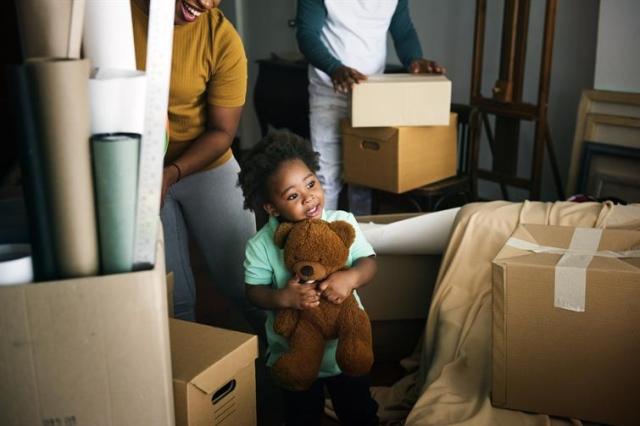Whether you’re moving across the country, to a new neighborhood, or into a new city, moving can be very stressful. Moving with family (especially children) can be even more complicated and dealing with changes can make them feel anxious as well. However, there are some steps parents can take so moving day runs a bit smoother.
Prepare for Moving Day
Being proactive is the biggest way to help alleviate stress during move-in day. Depending on the ages of the children, preparation will vary, but here are some helpful tips regardless of age:
- Break the news about moving to your children well in advance. Give them time to accept the move, especially if they are too young to understand the concept of moving or have close friends. Address any questions or concerns they might have during a family meeting.
- Be empathetic and understand that your kid(s) might also be stressed or anxious about moving. They might even be more boisterous or rebellious than usual depending on their age. It could take weeks or months for them to adjust to living in a new home.
- Evaluate what your family can afford and consider paying for convenience. Hiring professional movers or cleaners might be easier than trying to DIY everything with three toddlers.
- Some companies offer relocation services to cover expenses while others work with vendors who can provide discounts. Either way, do your research and determine if you want to use your employer’s relocation services.
- Begin packing well in advance. You’ll likely need more time than you think and if you rush, you might end up packing something you don’t need anymore. Save time, money, energy, and resources by allotting plenty of time to sort items and pack.
- Begin by packing items your family uses the least like holiday décor or off-season clothing.
- Slowly begin packing more essential items as you get closer to moving day.
- Make sure to label all boxes with the room and a brief description of its contents, so you aren’t scrambling to find the bottle warmer or coffee pot once you move in.
- Pay attention to weather trends and prepare accordingly.
- Kids might play with empty boxes and dollies. Since both are hazards, make sure these items aren’t near the children to avoid any accidents.
- Pack several essentials kits before move-in day
- Pack meals, snacks, drinks, and water in a cooler the day before move-in so it’s easy for kids to grab food when they are hungry.
- Pack a first-aid kit. Make sure to place any emergency medicine like an epinephrine autoinjector or inhaler in the kit as well.
- Pack a kit with a blanket, pillow, and other comfort items if they take naps.
- Determine what items must be taken on the car ride or flight to your new house or apartment and place them in a bag. This includes favorite toys, bedtime blankets, white noise machines, tablets, books, etc. Having these items handy can help maintain a sense of stability and familiarity. These items can also help keep the kids entertained and relaxed.
Moving with infants and toddlers
Kids under the age of six are usually the easiest to move, but they might not be able to fully understand what moving means, so communicating clearly is essential.
- Try explaining the move with a story, toys, video, or a book so they can know what to expect.
- Avoid introducing other major changes in their routine. For example, if you have a toddler it might be better to wait to begin potty training or weaning them off a pacifier.
- If you can swing it, try to arrange their furniture in a way that resembles their old room. Depending on the child, it might be a good idea to hold off on buying new furniture too.
- If your new home or apartment is close enough, try stopping by so the child is already familiar with the area.
- Arrange for your baby or toddler to stay with a babysitter, friend, or family member during moving day. You can also invite the caretaker to spend the day with the family during moving day if you prefer.
- If you have an infant, prepare a diaper bag with essentials (wipes, change of clothing, diapers, bottles, etc.) the night before.
School-age children
Kids in elementary or middle school understand what moving means and it might be easier to talk to them about relocation, but it’s a good idea to remain proactive.
- Aim to move during the summer to avoid abruptly disrupting their school year. There is a chance your child could be ahead or behind in certain subjects if they move in the middle of the year. However, some families aim to move mid-year so their children can make new friends and help make the transition into a new school easier.
- Gather the most recent report cards, transcripts, medical records, and other necessary documents for enrollment at your child’s new school. Sometimes the current school can send over these documents directly to the new school.
- Consider having your child stay with a friend, family member, or babysitter on move-in day.
Teenagers
Many teenagers have a group of best friends, a romantic partner, or are involved in extracurriculars that are important to them, so it’s very common for them to be apprehensive about moving. Moving away could also mean they will miss out on milestone events like prom or graduation that they have dreamed of experiencing with their friends.
- Let your teen know your family will be moving as soon as possible. Give them enough time to process the idea of moving so they can prepare accordingly. Waiting to tell your teen about a cross-country move a few weeks before move-in day could lead to resentment and negative behavior.
- Communicate with your teen and let them know that you understand their concerns. However, be prepared for them to be upset. They might not want to even have a conversation the first time you break the news.
- Host a going-away party a few weeks before the move so they can enjoy being with their friends one last time.
- Suggest the possibility of letting them take a trip to their old neighborhood or inviting their old friends into your new home.
- Offer to let them return for a few major events like prom or homecoming.
- Some families will allow older teens (17 or 18) to stay will a friend or relative until the end of the school year. This is an option if you feel comfortable doing so.
- Consider letting your teen invite a friend or two over to help them pack their room.
What to Look for in a Family-Friendly Apartment
When looking for a family-friendly apartment, begin by considering the size and long-term needs of your family to determine how much square footage you might need. For example, if you currently have three children, but one of them is about to go to college out-of-state, you can probably downsize.
When apartment hunting, look for communities with kid-friendly amenities like playgrounds, an onsite-daycare, and family-friendly events like ice cream socials. When touring apartments, ask about what safety features the apartment offers. Is the community gated? Does the unit have a security system? Does the swimming pool have a locking gate? These are a few examples of safety features to keep an eye out for. If you have younger children, it’s probably best to avoid apartments with balconies, unless they are child safe.
How to Find a Family-Friendly Neighborhood
Having access to an excellent school is a top priority for parents looking for family-friendly neighborhoods. Depending on the needs of the child, finding a great school varies per family. Perhaps your child is a talented artist so sending them to a performing arts school is important. Busy parents might need after-school care while parents with teenagers aim to enroll in a school with AP classes and plenty of extracurricular activities. Parents of children with disabilities value accessibility and support programs. Regardless of your children’s needs, it’s important to do extensive research before deciding on their new school.
Along with looking at online reviews and forums, reach out to the school’s PTA and ask to speak to a few parents. Do a tour of the school and meet with administrators and teachers before making a decision. If you have an infant or toddler, do a tour or ask for a trial week before enrolling your child. If you’re looking in a city or large metro area like Atlanta or Los Angeles, keep in mind that school districts can greatly vary.
Along with great schools, having access to plenty of sidewalks, parks, green space, and grocery stores is also important to families. A quick search on Google Maps can give you an idea of what amenities are located in and around your neighborhood. You can also look up information about neighborhood safety and crime, but beware that reviews and forums won’t be able to give the complete picture. If you can, try to talk to people in the neighborhood who have lived in the area for years. When looking for apartments or houses to rent, make sure to do a tour of the neighborhood and surrounding areas. Take note of overgrown yards, trash, and other unsightly features that usually indicate that the neighborhood might not be the best.
Have a Moving Checklist
Creating a moving checklist will help manage the logistics of moving with a family. Staying organized will help alleviate stress because it’s a visual reminder of what needs to get done. The list will vary depending on the needs of each family, but here is an example checklist with a suggested timeline you can use as a starting point:
Eight to four weeks (or more) before moving day
- Begin speaking with your children about the move (we recommend doing it even sooner, if possible)
- Decide if you want to hire a professional moving company or DIY
- Book movers and/or begin gathering materials for the move
- Begin packing and decluttering your home
- Throw away, sell, or donate items your family no longer wants or needs
- Ask your pediatrician, dentist, orthodontist, etc. for references
- Get copies of medical records and immunization documents for each family member
- Get set up with new physicians (in case your child gets sick, breaks a bracket on their braces, or experiences another emergency)
- Book a reliable car shipping company or purchase plane tickets
Three to four weeks before moving day
- Reach out to your child’s current school to obtain their transcript and other documents for the new school
- Enroll your children in their new school
- Continue packing
Two weeks before moving day
- Begin having your kids say goodbye to their friends and host a going-away party
- Secure a babysitter, family member, or friend who can look after children during moving day
- Transfer utilities and arrange for reconnection
- Set mail up forwarding and change your address
- Update licenses
- Get the family car serviced
- Continue packing
One week before moving day
- Finish packing the home
- Begin packing your essential kits (first aid kits, medications, comfort items, chargers, etc.)
- Set aside enough clothes for the next two weeks in a suitcase or bag
- Begin to disassemble large furniture. Place screws and other hardware in a plastic bag in a safe place like a toolbox
- Use up the last of your food supplies and begin throwing out or donating food you won’t be able to eat in time
- Write a grocery list of ingredients for easy-to-make meals for your first few days
- Plan your car trip and schedule stops for food, gas, and bathroom breaks
- Begin cleaning each room of the home
- Schedule move-in walk-through with landlord or property manager
The day before moving day
- Have the kids go to bed earlier than usual so they have the energy to wake up early
- Double-check essential kits
- Prepare meals, snacks, drinks, and water in a cooler
- Prepare diaper bag and bottles
Moving day
- Wake up the children early and feed them breakfast
- Take your kids to the babysitter or give the babysitter instructions as to where to stay while the move is happening
- Begin moving items onto the moving truck
- Finish cleaning the home
- Do a final check of every room in the house to make sure nothing is left behind
- Turn off lights
- Lock all doors and windows
- Complete move-in walk-through using your walk-through checklist
- Take photos and videos of the new home
- Move items into the new home
- Order take-out for dinner
Day after moving
- Stock fridge
- Begin childproofing the home
- Begin unpacking. Start with the kitchen, bathroom, and move onto other rooms
Ways to Involve Children in the Moving Process
Getting your child involved in the moving process can help them adjust to the changes. Depending on their age, let them help pack their rooms. Let them pick out old toys or clothing to sell or donate. You can also let your children pick out a few items for their new room. If they are old enough, bring them along while touring apartments and potential schools. If you’re moving across the country, show your children photos and videos of their new home and city. This is a great time to teach some life skills and your kids will appreciate being included. Even younger kids might get inspired by their parents and ask to help carry a small box or two on moving day!






